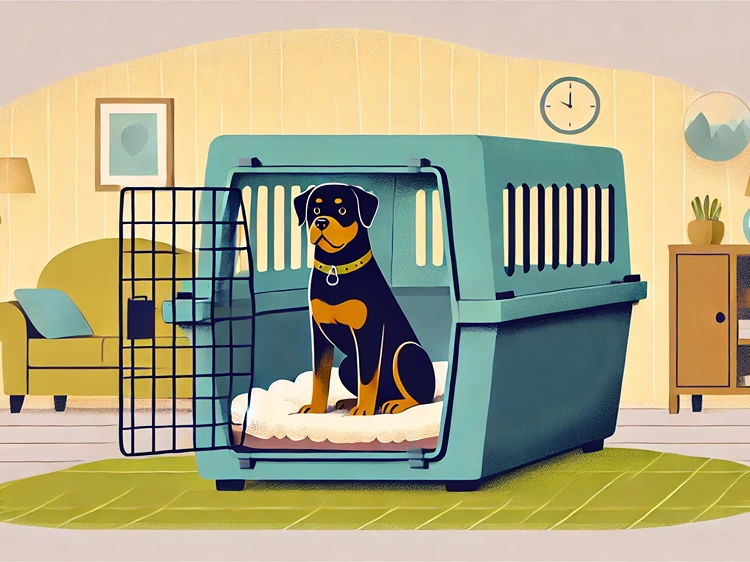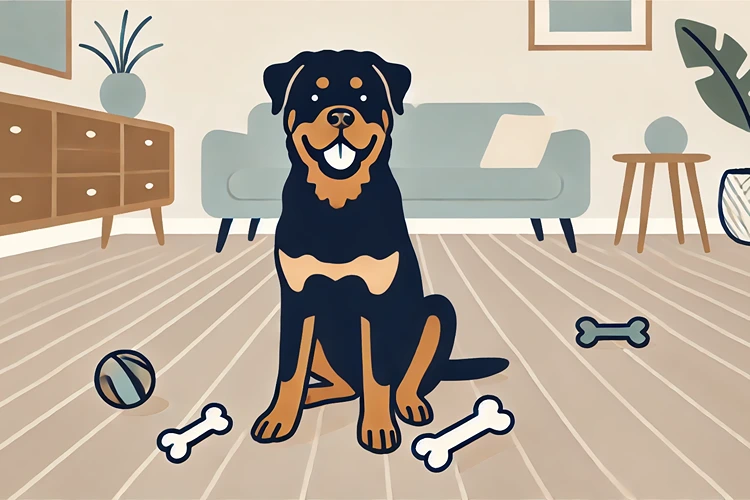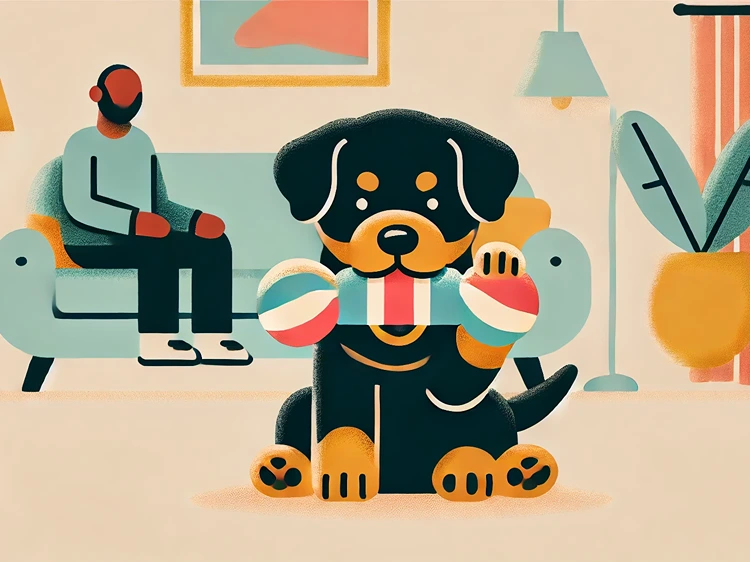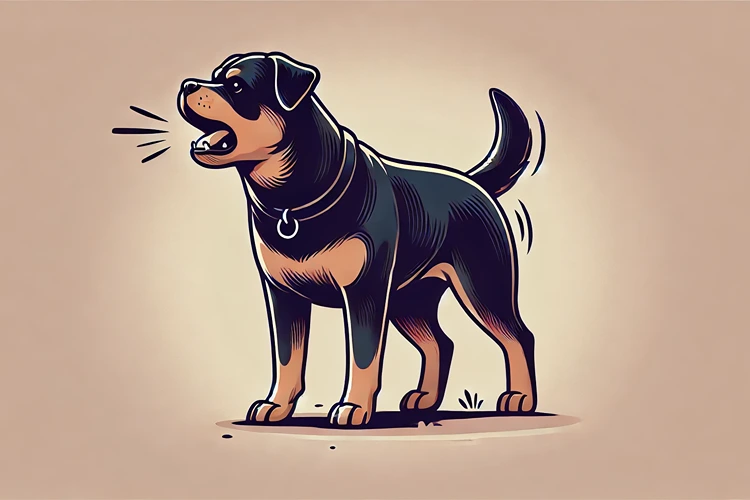Crate training is a fundamental part of raising a well-behaved and happy Rottweiler. While some dog owners might initially be hesitant about the idea of crate training, it’s important to understand that a crate offers your Rottweiler a safe, secure space they can call their own. The key to successful crate training lies in setting up the crate correctly and ensuring it’s a positive experience for your dog. In this guide, we’ll explore everything you need to know about how to set up a safe crate for your Rottweiler, along with tips for effective training.
What Size Crate Does a Rottweiler Need?
One of the first considerations when setting up a crate for your Rottweiler is ensuring that it’s the right size. Rottweilers are a large and powerful breed, and they need plenty of space to feel comfortable. A crate that’s too small can make your dog feel cramped and stressed, while a crate that’s too large may not provide the sense of security they need.
Recommended Crate Features for Rottweilers
| Feature | Why It’s Important |
|---|---|
| Durable Construction | Rottweilers are strong dogs, so a crate made from heavy-duty materials is necessary to withstand their strength. |
| Proper Ventilation | Ensure adequate airflow to keep your Rottweiler comfortable, especially during warm weather. |
| Removable Tray | Makes cleaning easy in case of accidents, keeping the crate hygienic. |
| Lockable Latches | Prevents accidental escapes and ensures your Rottweiler stays secure when crated. |
| Divider Panel | Useful for adjusting the size of the crate as your Rottweiler grows, ensuring a snug, comfortable fit during puppyhood. |
Choosing the Right Crate Dimensions
For an adult Rottweiler, a crate that measures around 48 inches in length, 30 inches in width, and 33 inches in height is usually ideal. This size allows enough room for your Rottweiler to stand up, turn around, and lie down comfortably without feeling restricted. If you’re crate training a Rottweiler puppy, you might want to invest in a crate with a divider, which can be adjusted as your puppy grows.
Paw-some Tip:
When choosing a crate, opt for one with a removable tray at the bottom. This makes cleaning up any accidents much easier and ensures your Rottweiler’s crate remains a hygienic and pleasant space.
Where Should You Place the Crate?
The location of your Rottweiler’s crate plays a crucial role in how comfortable and secure they feel. Ideally, the crate should be placed in a quiet area of your home where your dog can rest without too much disturbance. However, it’s also important that your Rottweiler doesn’t feel isolated from the rest of the family.
Choosing the Best Spot in Your Home
A corner of the living room or a quiet part of your kitchen can be a great spot for the crate. Avoid placing the crate in high-traffic areas or near noisy appliances like washing machines or dishwashers. Additionally, make sure the crate isn’t directly in front of a window, as too much external stimulation can make it difficult for your Rottweiler to relax.
Making the Crate Comfortable
Comfort is key when it comes to encouraging your Rottweiler to use their crate willingly. A hard, cold crate floor is not inviting, so it’s important to add some soft bedding. However, you’ll also want to ensure the bedding is durable and easy to clean, given the breed’s tendency to chew.
Choosing the Right Bedding
Opt for bedding that is both comfortable and durable. Orthopedic dog beds or high-quality, chew-resistant mats are excellent choices. They provide the support your Rottweiler needs, especially as they age and become more prone to joint issues. Be sure to wash the bedding regularly to keep it fresh and free from odors.
Introducing Your Rottweiler to the Crate
Introducing your Rottweiler to their crate in the right way is essential for effective crate training. The goal is to ensure your dog associates the crate with positive experiences, so they feel safe and content when inside.
Step-by-Step Introduction Process
Start by leaving the crate door open and allowing your Rottweiler to explore it on their own. You can encourage them by placing some of their favorite toys or treats inside the crate. Once your Rottweiler is comfortable going in and out of the crate, begin feeding them their meals inside it. This helps build a positive association with the crate. Gradually, you can start closing the door for short periods while they’re inside, always ensuring they remain calm and relaxed.
Common Mistakes to Avoid
One common mistake is forcing your Rottweiler into the crate, which can create negative associations. Another is leaving them in the crate for too long, especially when they’re not yet fully accustomed to it. Always ensure that crate time is a positive and short-lived experience in the beginning.
Rottie Stats:
According to a recent survey, 85% of dog owners who properly introduce their dogs to crates report that their pets see the crate as a positive space within the first two weeks.
How Long Should a Rottweiler Stay in the Crate?
Understanding the appropriate amount of time your Rottweiler should spend in the crate is essential for their well-being. While crates are a useful tool, they should never be overused or used as a means of punishment.
Guidelines for Crate Time
For a puppy, the general rule is that they can stay in the crate for their age in months plus one hour. For example, a three-month-old puppy should not be crated for more than four hours at a time. Adult Rottweilers, on the other hand, can typically handle being in a crate for up to eight hours, but this should be an exception rather than the rule. It’s important to ensure your dog gets plenty of exercise and mental stimulation outside of crate time.
Effective Crate Training Strategies for Rottweilers
Crate training your Rottweiler effectively requires patience, consistency, and a positive approach. By following the right strategies, you can ensure that your dog not only accepts the crate but also enjoys spending time in it.
Start with Short, Positive Sessions
Begin crate training with short sessions, gradually increasing the time as your Rottweiler becomes more comfortable. Initially, keep the crate door open and let your dog explore it at their own pace. You can make the crate more appealing by placing their favorite toys or a treat inside. The goal is to create a positive association with the crate right from the start.
Use the Crate for Short, Controlled Periods
Once your Rottweiler is comfortable entering the crate voluntarily, you can start closing the door for short periods. Stay close by and reassure your dog with a calm voice. Gradually increase the time your dog spends in the crate, always ensuring that they remain calm and relaxed. Remember, the crate should never be used as a punishment; it’s a safe space for your Rottweiler.
Paw-some Tip:
To help your Rottweiler feel more comfortable, place the crate near a familiar item like a blanket that smells like you or your dog’s favorite toy. Familiar scents can help ease any anxiety your Rottweiler might feel in the beginning stages of crate training.
Addressing Common Crate Training Challenges
Crate training is not always a smooth process, and you may encounter a few challenges along the way. Understanding these challenges and knowing how to address them can make the training experience more positive for both you and your Rottweiler.
What to Do If Your Rottweiler Whines in the Crate
It’s common for dogs to whine when they’re first introduced to the crate. This is usually a sign of anxiety or a need for attention. If your Rottweiler whines, avoid immediately letting them out, as this can reinforce the behavior. Instead, wait until they’ve stopped whining, even if just for a few seconds, before opening the crate door. This teaches your dog that calm behavior is rewarded.
Handling Separation Anxiety
Rottweilers are known for their strong bond with their owners, which can sometimes lead to separation anxiety. If your dog becomes anxious when left alone in the crate, try to make the experience as comforting as possible. Gradually increase the time they spend alone in the crate and leave them with something engaging, like a puzzle toy, to keep them occupied.
Crate Safety: Ensuring Your Rottweiler’s Well-being
While crate training is generally safe, it’s essential to take a few precautions to ensure your Rottweiler’s well-being. By following these safety tips, you can avoid potential issues and keep your dog happy and secure.
Checking for Hazards Inside the Crate
Before placing your Rottweiler in the crate, check for any potential hazards, such as loose wires, sharp edges, or small objects that could be swallowed. Ensure that the crate is well-ventilated and that the door latch is secure but easy to open in case of an emergency.
Monitoring Your Dog During Crate Time
It’s important to keep an eye on your Rottweiler during the initial stages of crate training, especially if they’re prone to anxiety or destructive behavior. Use a baby monitor or a pet camera to observe your dog when you’re not in the room. This allows you to intervene if your dog becomes overly distressed or if there are any signs of trouble.
Rottie Stats:
Research shows that dogs who are properly crate-trained are 50% less likely to develop behavioral issues such as excessive barking or chewing.
Using the Crate as a Training Tool
Beyond just being a safe space, the crate can be a powerful tool for training your Rottweiler. When used correctly, it can help with housebreaking, reducing destructive behaviors, and even establishing a routine.
Crate Training for Housebreaking
One of the most common uses of a crate is for housebreaking. Dogs naturally avoid soiling their sleeping area, so a crate can be a helpful tool in teaching your Rottweiler to control their bladder. Establish a regular feeding schedule and take your dog outside immediately after meals, naps, and playtime. Consistency is key, and over time, your Rottweiler will learn to associate the crate with proper bathroom behavior.
Crate Training to Prevent Destructive Behaviors
Rottweilers, especially when young, are known for their chewing habits. A crate can be a safe place for your dog to stay when you’re not able to supervise them. Provide plenty of chew toys and rotate them regularly to keep your dog engaged and reduce the temptation to chew on household items. Crate time can also help prevent your Rottweiler from getting into mischief when you’re not around.
Benefits and Drawbacks of Crate Training a Rottweiler
Pros
- Provides a safe and secure space for your Rottweiler, reducing anxiety and promoting well-being.
- Facilitates housebreaking by encouraging your dog to hold their bladder, leading to fewer indoor accidents.
- Helps prevent destructive behaviors, especially when your Rottweiler is unsupervised, protecting your home and belongings.
- Offers a controlled environment during recovery from injury or illness, promoting faster healing and safety.
- Improves travel safety by keeping your Rottweiler secure during car rides, reducing the risk of accidents.
Cons
- Rottweilers with strong separation anxiety may initially struggle with being confined, leading to stress.
- Improper or excessive use of the crate can result in behavioral issues, such as increased aggression or fearfulness.
- Requires consistent training and patience, which may be time-consuming for some owners.
- May not be suitable for older Rottweilers with mobility issues if the crate isn’t easily accessible.
- Can lead to frustration or discomfort if the crate size or setup is not appropriate for your Rottweiler’s needs.
Transitioning Out of the Crate
As your Rottweiler becomes more mature and trustworthy, you may decide to transition them out of the crate. However, this should be done gradually and with care to ensure that your dog continues to feel secure and comfortable.
When to Consider Crate-Free Time
Typically, around the age of two or three years, many Rottweilers become reliable enough to be left out of the crate when you’re not home. However, this varies depending on the individual dog’s behavior and comfort level. Start by giving your Rottweiler short periods of crate-free time, gradually increasing the duration as they demonstrate good behavior.
Maintaining Structure and Routine
Even as your Rottweiler spends less time in the crate, it’s important to maintain a consistent routine. Continue to provide a safe space, such as a designated area in your home where your dog can relax. Keeping a structured routine helps your dog feel secure and can prevent any regression in training.
FAQs
Wrapping Up
Crate training is an invaluable tool for raising a well-behaved and secure Rottweiler. By carefully selecting the right crate, creating a comfortable environment, and using consistent training methods, you can ensure that your Rottweiler views their crate as a safe and positive space. While there may be challenges along the way, understanding your dog’s needs and maintaining patience will lead to successful crate training. Remember, the crate is more than just a containment tool—it’s a sanctuary for your Rottweiler, helping them feel secure and aiding in their overall development. Implementing these strategies will not only make crate training a rewarding experience for your dog but also strengthen the bond you share with your loyal companion.




